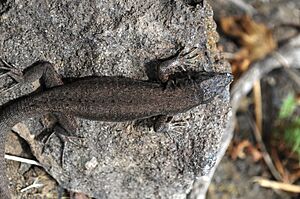Aeolian wall lizard facts for kids
Quick facts for kids Aeolian wall lizard |
|
|---|---|
 |
|
| Conservation status | |
| Scientific classification | |
| Genus: |
Podarcis
|
| Species: |
raffonei
|
| Synonyms | |
|
|
The Aeolian wall lizard (Podarcis raffonei) is a special kind of lizard. It's also called Raffone's wall lizard. This lizard belongs to the Lacertidae family, which includes many types of wall lizards. It is found only in Italy, meaning it is endemic there.
What's in a Name?
The scientific name of this lizard, raffonei, was chosen to honor Dr. Antonia Raffone. She was the wife of Dr. Antonino Trischitta. Dr. Trischitta was the person who first collected the original lizard specimen. This first specimen is called the holotype.
Where Do They Live?
The Aeolian wall lizard lives in specific natural places. These include areas with Mediterranean-type shrubs and plants. They also like rocky shores, which are common near the sea.
Where Can You Find Them?
You can only find the Aeolian wall lizard in four specific spots. All these places are small islands or islets in the Aeolian Islands of Italy. These locations are:
- The island of Strombolicchio
- A small islet near the island of Salina
- Another islet off the coast of the island of Filicudi
- Some areas on the island of Vulcano
Why Are They Rare?
The Aeolian wall lizard is very rare. There are only about one thousand of these lizards left. They live in a very small area, less than 20,000 square meters (about 0.008 square miles).
Scientists believe these lizards once lived in a much larger area. However, a common lizard called the Italian wall lizard was brought to these islands by people. The Italian wall lizard is very good at competing for food and space. This competition has caused the Aeolian wall lizard's population to shrink. Now, they only survive in these tiny, isolated spots.


